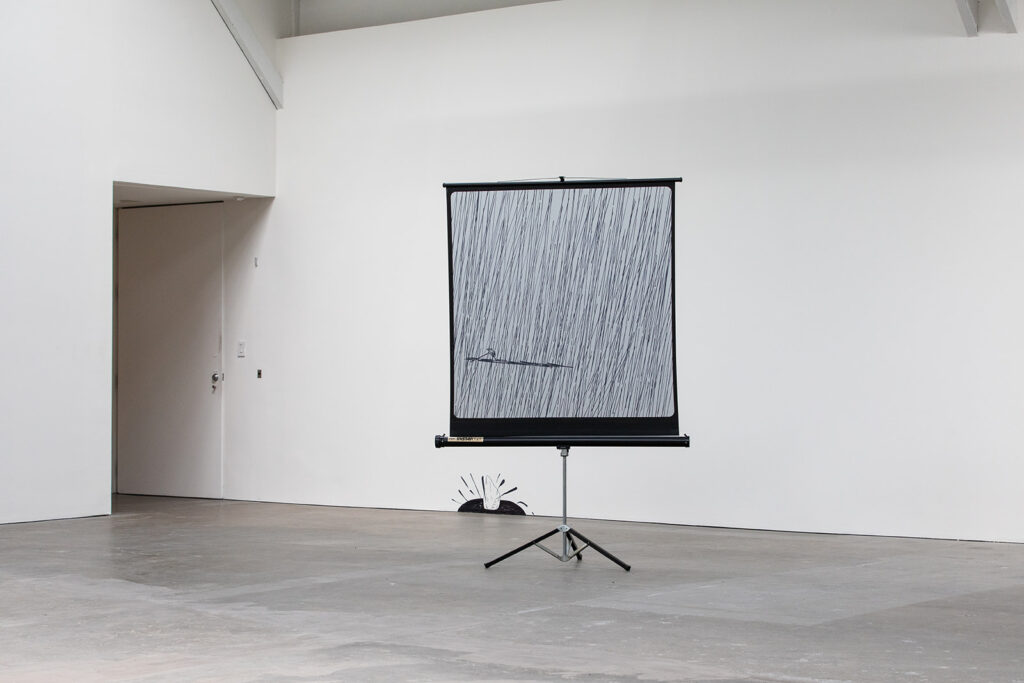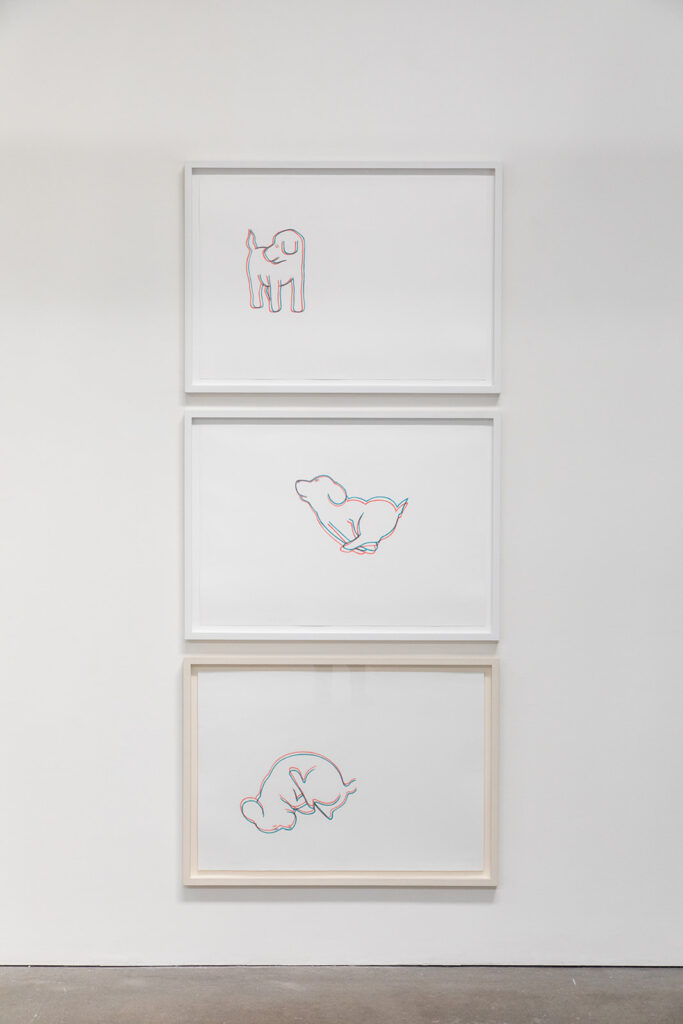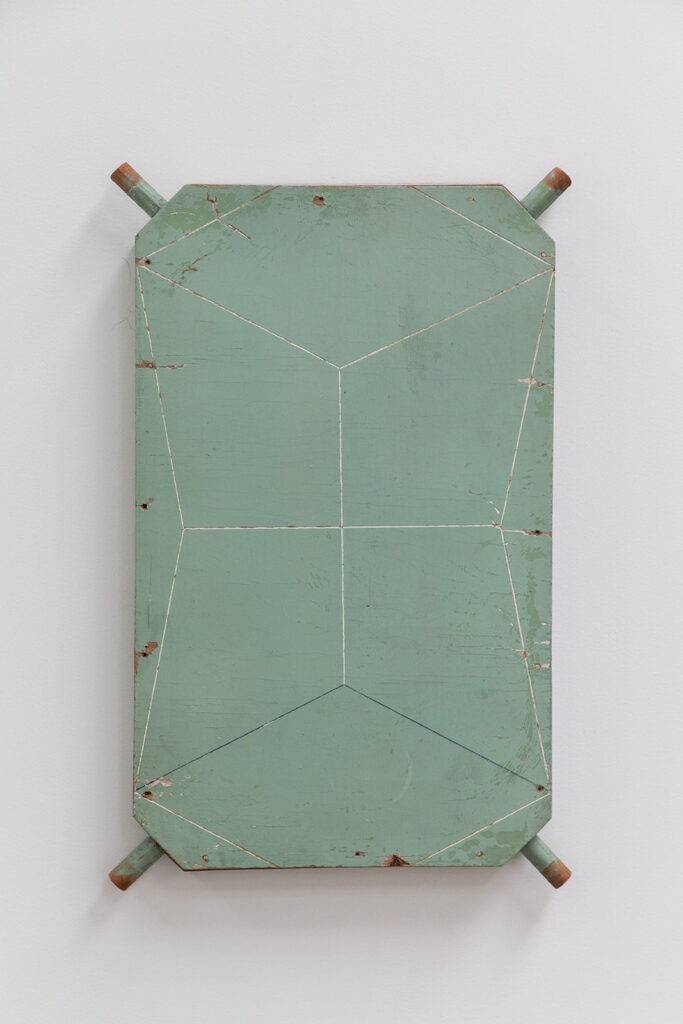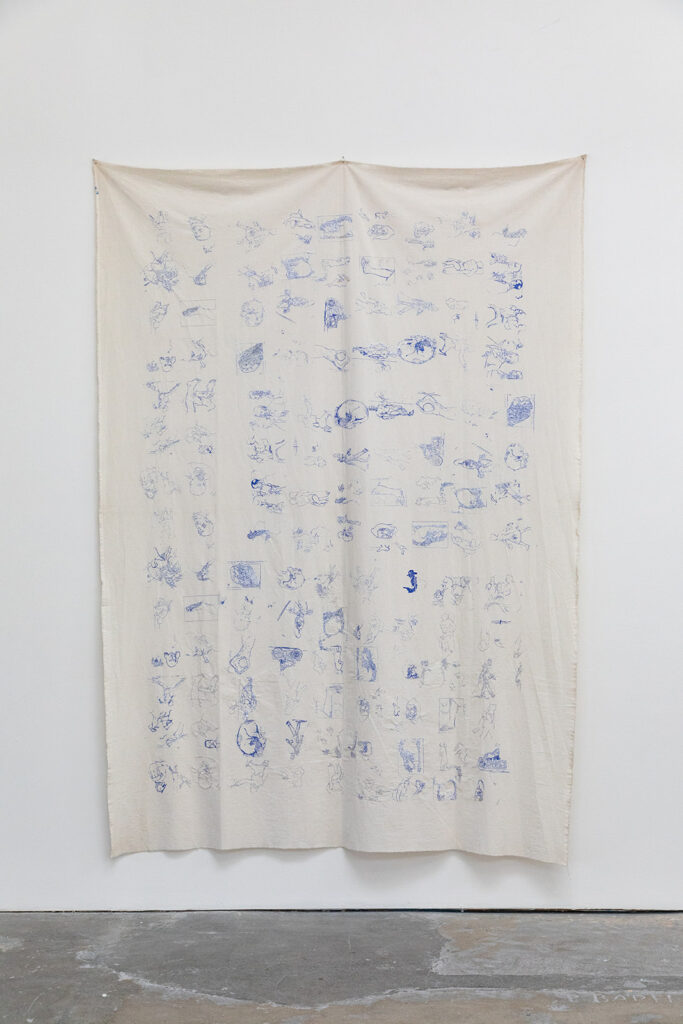Ana Jotta’s solo show, “Never the Less” (through November 11 at The Wattis Institute for Contemporary Arts, SF), features an eclectic ensemble of works from various points in her career that blur boundaries between work and play, handiwork and appropriation, cynicism and sincerity, embracing slippage in language and translation–all gathered under the umbrella of drawing in the many senses of the word.
Jotta’s (b. 1946 Lisbon, Portugal) prolific artistic career has spanned decades, and her work has been exhibited widely throughout the EU. This exhibition is the artist’s first solo show in the US and serves as a first exposure to her work for many (myself included), although during the opening reception the curators Anthony Huberman and Miguel Wandschneider urged viewers not to extrapolate from this as a “representative sample” of her work. Microcosm of her practice or not, the amuse-bouche left me equal parts intrigued, confused, and wanting to see more of Jotta’s universe.
The multifariousness of this exhibition can’t be overstated (embroidery, found/altered objects, drawings in various forms, serigraphs, sewn leather scraps, video footage showing spreads from her journals, an artist book, a calendar, wallpaper…). Throughout the gallery, Jotta has hand-drawn cartoonish figures on the wall with sharpies and pastels: a swan dipping down into a jet-black puddle, a chain of ants carrying pillow-case bindles surrounding the gallery reception desk, among various other characters who seem to be borrowed from animation or children’s books but aren’t always so familiar that one could easily trace their origins.
These interventions are the only new works created for the show–many of the other pieces were “orphaned” (Jotta’s expression) from their larger series/families for this exhibition, a further exploration into decontextualization.

“Chuva da Tarde” (afternoon rain), 2008, is drawing done directly onto a silver portable projection screen with a built-in tripod like a traveling salesman in the 70s might use. In navy and black sharpie, pelts of rain are suggested by intermittent criss-crossing diagonal lines, and there is a small figure in a boat in the lower left of the composition. This image is in fact a small segment appropriated from a 19th century woodcut by Utagawa Hiroshige, “Sudden Shower over Shin-Ohashi Bridge” (also famously copied by Van Gogh). The aura of the scene is markedly different with the change of scale, quality of line, and surface of the object as Jotta has presented it.
Referencing the original, we can see that Jotta “zoomed in” on Hiroshige’s woodcut, but also selectively removed the additional context of the landscape behind the figure as well as the bridge with passers by below. The lone figure is dwarfed by a sea of rain. Jotta’s mode of display cheekily nods to the fact that many painters use projectors as part of their process to work from photographs or scale up drawings. But her choice of imagery contains a potential critique of the art market as well, secretly needling any potential customer of this work.
Hiroshige’s print was created during Japan’s Edo period as part of the Ukiyo-E genre, which roughly translates to “pictures of the floating world”—intricate prints that were popular with the wealthy Chonin class in Japan who displayed them in their homes. Jotta’s iteration, teetering on the edge between drawing and sculpture, suspended in midair on a tripod, foregrounds the fact that screens and images can simultaneously be a portal to another world and obstruct our view. There are limits to the depth that a two dimensional image can achieve, but yet a concise poetry in the fact that a series of diagonal lines placed just so can suggest an entire weather pattern.

Just behind the screen to the right are three large untitled anaglyph drawings in blue and red colored pencil that depict a puppy in various playful positions. The further away from the drawings you are (and if you squint a little), one’s stereoscopic vision makes the staggered lines converge into a black outline, even without 3D glasses. This particular dog is borrowed from the embossed pattern of the mascot for the toilet paper brand Scottex.
Help us save local journalism!
Every tax-deductible donation helps us grow to cover the issues that mean the most to our community. Become a 48 Hills Hero and support the only daily progressive news source in the Bay Area.
The specific provenance of Jotta’s references (or footnotes, as the artist has called them previously) becomes less emphasized than the operations applied to these phrases and imagery, as well as the sheer breadth of her source material, which equally privileges found objects (eg. a used dish towel) with art historical imagery and characters from various comics, among other heterogeneous roots.
Jotta’s collapsing of these different streams of information in her practice reflects our experience of moving through life much more closely than hermetically-sealed attempts by some contemporary artists to reference the history of art as if it were separate from the rest of our messy existence. We encounter vast streams of objects, images, advertisements, and texts daily that are jumbled into a giant soup. These unexpected combinations are precisely what keeps life interesting.
One job of an artist is to process these disparate stimuli. But what do we make of the specific ingredients that Jotta has chosen to spend time with and recontextualize in this exhibition and beyond? To play the game of tracing these references is often futile and even occasionally ill-advised, although I’m quite sure that the artist smiles as curators and writers try to use these sources as a rebus to “decode” her work or attempt to put a stake in the ground towards a singular meaning. The more one tries to force a solution to the puzzle “what do the Scottex toilet paper dog and a 19th Century Hiroshige woodcut have in common?”, the more we begin to chase our own tail.

We need not necessarily find a logical reason behind things for them to have significance in our lives, Jotta’s work playfully reminds us. But the artist does have a knack for seeing the potential in fragments of images and materials in the world around her. “Torso” is a found piece of painted-green wood with pegs protruding from each beveled corner, in which the artist has inscribed a series of lines cutting through layers of paint that converge geometrically to resemble a tortoise shell. The word torso can of course refer to the trunk of a human body, but also to an unfinished work of art. On the lower half of the work, there is a line drawn in pen that is left uncarved. With care, attention, and labor, she highlights the significance of the seemingly insignificant. Conceptual rigor and care through handiwork need not be mutually exclusive.
When attempting to wrangle the disparate vectors of Jotta’s work, many have defined her practice by its steadfast refusal to stay in a single lane. What does it mean to deem someone’s artistic practice uncategorizable? Jotta’s commitment to a variegated approach (not sticking to a particular medium or mode of representation) becomes a somewhat subversive act in a climate where artists are not-so-subtly steered towards creating a personal brand and easily recognizable style through consistency of approach and materials—in order to make themselves more palatable (and therefore marketable).

Nevertheless, Jotta’s hand is quite visible in this exhibition, and her relationship to authorship is much more multivalent than what one would typically categorize within the genre of appropriation, brandlessness, or an embrace of the “death of the author.” “Esperanca” is a self-portrait through a side door. While she avoids being pinned down, she still leaves her mark. On the back of the screen of “Chuva da Tarde” (the only work where we can see the verso in the exhibition), the work is signed with a simple J in a circle. The glyph is her play on a copyright symbol, and a reference to the confusion created by phonetic pronunciation of her last name in Portuguese, which sounds just like the letter “J”.
A polyglot who speaks Portuguese, French, and English (and exploits double meanings whenever possible), Jotta has left many linguistic easter eggs throughout the exhibition for those who spend time with the work. Tucked away in the back hallway leading to the Wattis’ bathroom, a photograph of a teapot is pasted onto the wall with blue-gray wafts of pastel steam emanating outward. Nearby, printed on an index card-sized piece of pink paper, is a soliloquy uncannily similar to a line from a famous quote by Theodore Roosevelt that she’s tweaked to reflect her own ends: “Don’t flinch, don’t fall, keep the light on.” Jotta speaks softly but she carries a big stick.
NEVER THE LESS runs through November 11 at The Wattis Institute for Contemporary Arts, SF. More info here.





